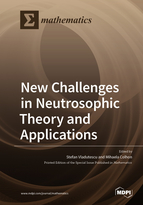New Challenges in Neutrosophic Theory and Applications
A special issue of Mathematics (ISSN 2227-7390). This special issue belongs to the section "Fuzzy Sets, Systems and Decision Making".
Deadline for manuscript submissions: closed (31 May 2020) | Viewed by 55642
Special Issue Editors
Interests: qualitative social research; communication and media and metaphysics
Interests: artificial intelligence; knowledge representation and reasoning; natural language processing; human-computer interaction
Special Issues, Collections and Topics in MDPI journals
Special Issue Information
Dear Colleagues,
Since its first development in 1995, Neutrosophy has been the basis of neutrosophic logic and neutrosophic sets. Neutrosophic sets and logic are generalizations of fuzzy and intuitionistic fuzzy sets and logic. Since then, studies about “neutrosophy” and its derivatives, such as “neutrosophic logic”, “neutrosophic set”, “neutrosophic probability”, and “neutrosophic statistics”, have been applied in various domains, starting from computational intelligence, clustering, control, data analysis and data mining, decision making and support, design, human factors engineering and ergonomics, information processing and retrieval, knowledge representation and reasoning, all the way to image processing, medical diagnosis, optimization, pattern classification, production planning and scheduling, quality control, natural language processing, etc.
We welcome authors to present new neutrosophic techniques, methodologies, mixed approaches, and research directions pointing to unsolved issues. Topics of interest include, but are not limited to:
- Neutrosophic sets
- Neutrosophic algebra
- Neutrosophic topology
- Neutrosophic graphs
- Neutrosophic probabilities
- Neutrosophic tools for decision making
- Neutrosophic theory for machine learning
- Neutrosophic statistics
- Neutrosophic numerical measures
- Classical neutrosophic numbers
- A neutrosophic hypothesis
- The neutrosophic level of significance
- The neutrosophic confidence interval
- The neutrosophic central limit theorem
- Neutrosophic theory in bioinformatics and medical analytics
- Neutrosophic tools for big data analytics
- Neutrosophic tools for deep learning
- Neutrosophic tools for data visualization
- Quadripartitioned single valued neutrosophic sets
- Refined single valued neutrosophic sets
Prof. Dr. Stefan Vladutescu
Prof. Dr. Mihaela Colhon
Guest Editors
Manuscript Submission Information
Manuscripts should be submitted online at www.mdpi.com by registering and logging in to this website. Once you are registered, click here to go to the submission form. Manuscripts can be submitted until the deadline. All submissions that pass pre-check are peer-reviewed. Accepted papers will be published continuously in the journal (as soon as accepted) and will be listed together on the special issue website. Research articles, review articles as well as short communications are invited. For planned papers, a title and short abstract (about 100 words) can be sent to the Editorial Office for announcement on this website.
Submitted manuscripts should not have been published previously, nor be under consideration for publication elsewhere (except conference proceedings papers). All manuscripts are thoroughly refereed through a single-blind peer-review process. A guide for authors and other relevant information for submission of manuscripts is available on the Instructions for Authors page. Mathematics is an international peer-reviewed open access semimonthly journal published by MDPI.
Please visit the Instructions for Authors page before submitting a manuscript. The Article Processing Charge (APC) for publication in this open access journal is 2600 CHF (Swiss Francs). Submitted papers should be well formatted and use good English. Authors may use MDPI's English editing service prior to publication or during author revisions.






